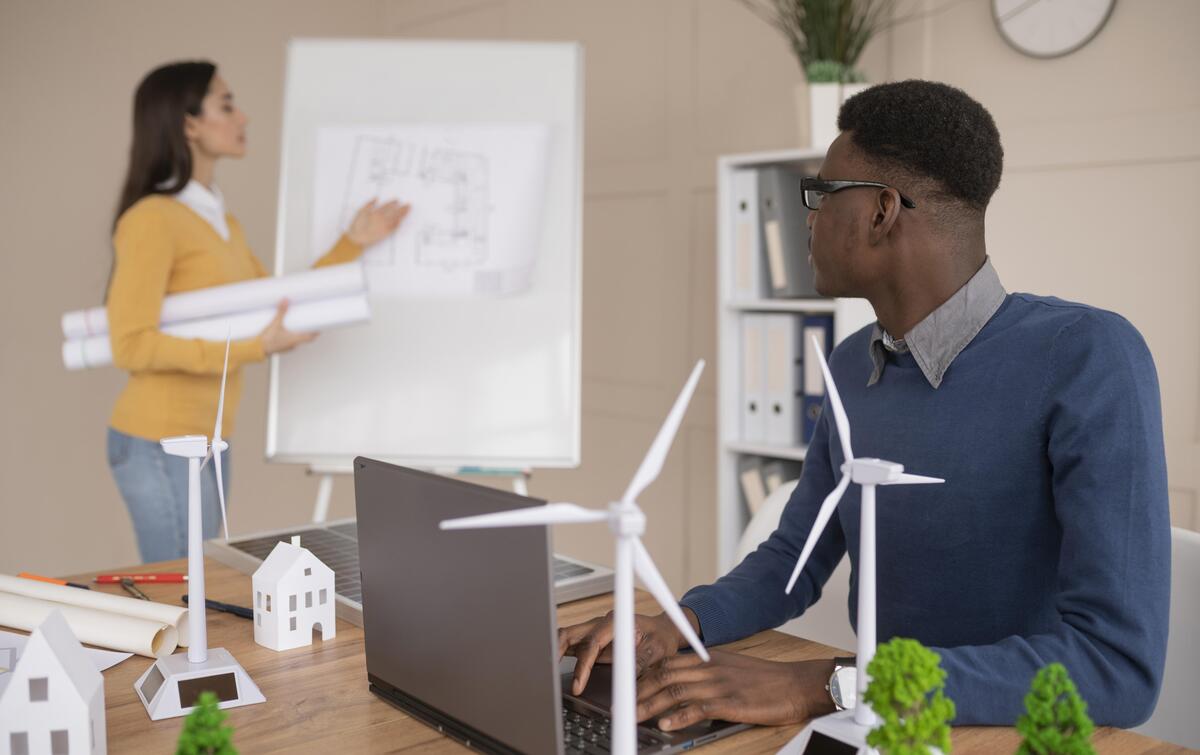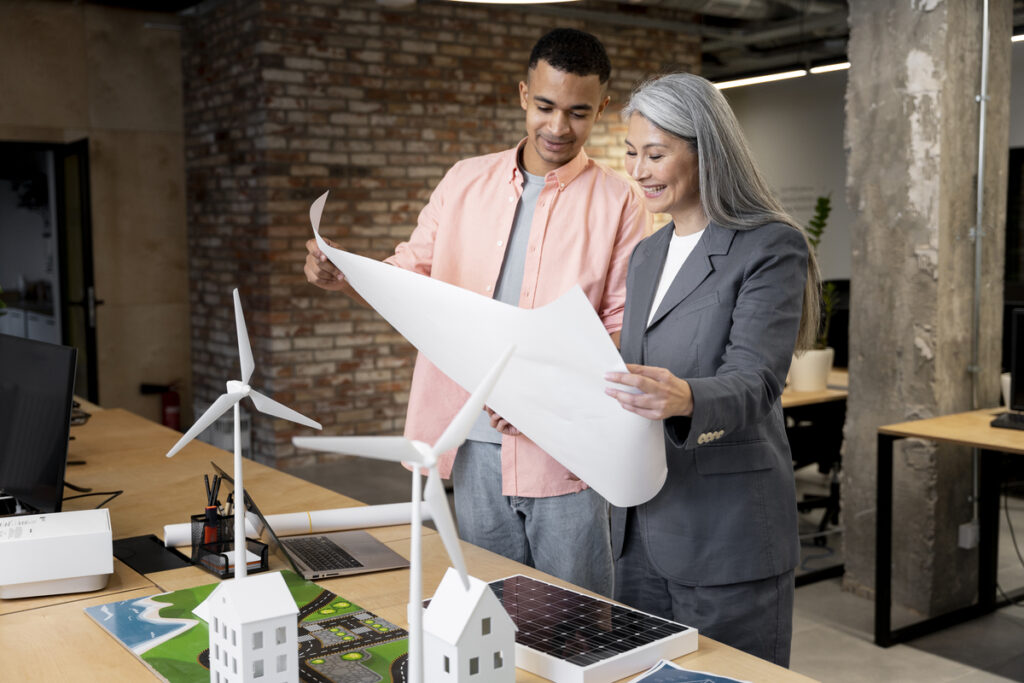The Sustainable Development Goals (SDGs) stand as a beacon of hope and collective ambition, representing a universal call to action to address the world’s most pressing challenges and build a sustainable future for all. Adopted by all United Nations Member States in 2015 as part of the 2030 Agenda for Sustainable Development, the SDGs encapsulate 17 interconnected objectives that encompass social, economic, and environmental dimensions of development. These goals tackle a wide range of issues, including poverty, hunger, health, education, gender equality, clean water and sanitation, sustainable energy, climate action, and more.
At the heart of the Sustainable Development Goals in Construction lies a commitment to leaving no one behind, ensuring that progress towards sustainable development is inclusive and equitable. The goals build on the successes and lessons learned from the Millennium Development Goals (MDGs) but go further by addressing the root causes of poverty, inequality, and environmental degradation. Achieving the SDGs requires transformative action, innovative solutions, and collective effort from governments, businesses, civil society, and individuals worldwide.
As we approach the midpoint of the 2030 Agenda, it is essential to reflect on the progress made towards the SDGs in construction, identify remaining challenges, and chart a course for accelerated action. This review examines the status of each goal, explores key opportunities and solutions, and underscores the urgency of advancing sustainable development to create a better future for current and future generations.
Table of Contents
Overview of the SDGs
The Sustainable Development Goals (SDGs) are a set of 17 interconnected objectives adopted by all United Nations Member States in 2015 as part of the 2030 Agenda for Sustainable Development. These goals address the most pressing global challenges, including poverty, hunger, health, education, gender equality, clean water and sanitation, sustainable energy, economic growth, infrastructure, inequality, sustainable cities, responsible consumption, climate action, life below water, life on land, peace, justice, and strong institutions, and partnerships for the goals.
They aim to end poverty, protect the planet, and ensure prosperity for all by 2030. The SDGs build on the success of the Millennium Development Goals (MDGs) but go further by tackling the root causes of poverty and promoting sustainable development in all its dimensions. Achieving the SDGs requires collective action and collaboration among governments, businesses, civil society organizations, and individuals worldwide.
Progress towards the goals is regularly monitored and evaluated to ensure accountability and to guide efforts towards a more sustainable and equitable future for current and future generations.
Suggested article to read: Sustainable Construction Technology; Ultimate Guide in 2025

What are the 17 Sustainable Development Goals (SDGs)?
The 17 Sustainable Development Goals (SDGs) are a universal call to action to end poverty, protect the planet, and ensure that all people enjoy peace and prosperity by 2030. They were adopted by all United Nations Member States in 2015 as part of the 2030 Agenda for Sustainable Development. The SDGs build on the success of the Millennium Development Goals (MDGs) and aim to go further by addressing the root causes of poverty and the universal need for development that works for all people.
Here are the 17 SDGs:
- No Poverty: End poverty in all its forms everywhere.
- Zero Hunger: End hunger, achieve food security and improved nutrition, and promote sustainable agriculture.
- Good Health and Well-being: Ensure healthy lives and promote well-being for all at all ages.
- Quality Education: Ensure inclusive and equitable quality education and promote lifelong learning opportunities for all.
- Gender Equality: Achieve gender equality and empower all women and girls.
- Clean Water and Sanitation: Ensure availability and sustainable management of water and sanitation for all.
- Affordable and Clean Energy: Ensure access to affordable, reliable, sustainable, and modern energy for all.
- Decent Work and Economic Growth: Promote sustained, inclusive, and sustainable economic growth, full and productive employment, and decent work for all.
- Industry, Innovation, and Infrastructure: Build resilient infrastructure, promote inclusive and sustainable industrialization, and foster innovation.
- Reduced Inequality: Reduce inequality within and among countries.
- Sustainable Cities and Communities: Make cities and human settlements inclusive, safe, resilient, and sustainable.
- Responsible Consumption and Production: Ensure sustainable consumption and production patterns.
- Climate Action: Take urgent action to combat climate change and its impacts.
- Life Below Water: Conserve and sustainably use the oceans, seas, and marine resources for sustainable development.
- Life on Land: Protect, restore, and promote sustainable use of terrestrial ecosystems, sustainably manage forests, combat desertification, and halt and reverse land degradation and halt biodiversity loss.
- Peace, Justice, and Strong Institutions: Promote peaceful and inclusive societies for sustainable development, provide access to justice for all, and build effective, accountable, and inclusive institutions at all levels.
- Partnerships for the Goals: Strengthen the means of implementation and revitalize the global partnership for sustainable development.
These goals are interconnected and indivisible, meaning that success in one goal often relies on achieving progress in others. They are also universal, applying to all countries, regardless of their level of development. Governments, businesses, civil society, and individuals all have a role to play in working towards the achievement of these goals.
Suggested article to read: Top 24 Sustainable Construction Technologies in 2025
Progress Review
A progress review of the Sustainable Development Goals (SDGs) assesses the advancements made toward achieving the 17 goals since their inception in 2015. Here’s an overview of the progress across some key areas:
- Poverty Reduction (SDG 1): Progress has been mixed. While significant strides have been made in reducing extreme poverty, inequalities persist, especially in regions like sub-Saharan Africa and Southern Asia.
- Zero Hunger (SDG 2): Despite improvements in food security in many regions, hunger levels have been rising in recent years due to conflicts, climate change, and economic downturns.
- Good Health and Well-being (SDG 3): Progress has been made in reducing child mortality rates, improving access to healthcare services, and combating diseases like HIV/AIDS, malaria, and tuberculosis. However, the COVID-19 pandemic has highlighted vulnerabilities in global health systems.
- Quality Education (SDG 4): Access to education has expanded, but challenges remain in ensuring quality education for all, especially for marginalized populations and in conflict-affected areas.
- Gender Equality (SDG 5): While progress has been made in closing gender gaps in education and political representation, disparities persist in economic participation, access to decision-making roles, and protection from gender-based violence.
- Clean Water and Sanitation (SDG 6): Significant progress has been made in improving access to clean water and sanitation facilities, but disparities remain, particularly in rural areas and informal settlements.
- Affordable and Clean Energy (SDG 7): Renewable energy sources have gained traction, but access to modern energy services remains limited in many parts of the world, particularly in rural areas.
- Decent Work and Economic Growth (SDG 8): Employment rates have improved, but informal and precarious work remains widespread, and income inequality persists.
- Industry, Innovation, and Infrastructure (SDG 9): Investments in infrastructure and innovation have increased, but there are gaps in connectivity, especially in rural and remote areas.
- Reduced Inequality (SDG 10): Inequality within and among countries persists, with marginalized groups facing discrimination and limited access to resources and opportunities.
- Sustainable Cities and Communities (SDG 11): Urbanization continues, posing challenges related to congestion, pollution, inadequate housing, and unequal access to services.
- Responsible Consumption and Production (SDG 12): Efforts to promote sustainable consumption and production patterns have been insufficient, leading to environmental degradation and resource depletion.
- Climate Action (SDG 13): Despite increased awareness, greenhouse gas emissions continue to rise, exacerbating climate change impacts such as extreme weather events, sea-level rise, and biodiversity loss.
- Life Below Water (SDG 14): Marine ecosystems are under increasing pressure from overfishing, pollution, and habitat destruction, threatening marine biodiversity and livelihoods dependent on oceans.
- Life on Land (SDG 15): Deforestation, land degradation, and loss of biodiversity persist, posing threats to ecosystems, wildlife, and livelihoods.
- Peace, Justice, and Strong Institutions (SDG 16): Conflict, violence, corruption, and weak governance undermine efforts to achieve sustainable development and uphold human rights.
- Partnerships for the Goals (SDG 17): Collaboration among governments, businesses, civil society, and other stakeholders is essential for mobilizing resources, sharing knowledge, and driving progress towards the SDGs.
Overall, while some progress has been made across various SDGs, significant challenges remain in achieving the ambitious targets set for 2030. Accelerated and concerted efforts are needed to address these challenges and ensure that no one is left behind in the pursuit of sustainable development.
Suggested article to read: Sustainable Construction; Comprehensive Guide 2025
Challenges and Barriers
Several challenges and barriers hinder the achievement of the Sustainable Development Goals (SDGs). Here are some of the key obstacles:
- Lack of Political Will and Leadership: Without strong commitment from governments and leaders, progress towards the SDGs can be slow. Political instability, corruption, and competing priorities may divert attention and resources away from sustainable development efforts.
- Insufficient Funding and Resources: Adequate financing is crucial for implementing SDG-related initiatives, but many developing countries face challenges in mobilizing domestic resources and accessing external funding. Additionally, the COVID-19 pandemic has strained public finances, further limiting resources available for sustainable development.
- Inequality and Marginalization: Inequalities within and among countries pose significant barriers to achieving the SDGs. Marginalized groups, including women, children, persons with disabilities, indigenous peoples, and minorities, often face discrimination and lack access to essential services, education, employment, and decision-making processes.
- Climate Change and Environmental Degradation: Climate change and environmental degradation threaten progress across multiple SDGs. Rising temperatures, extreme weather events, deforestation, loss of biodiversity, and pollution exacerbate poverty, hunger, health issues, displacement, and resource scarcity, disproportionately affecting vulnerable populations.
- Conflict and Fragility: Conflict, violence, and instability disrupt development efforts and exacerbate humanitarian crises. Fragile and conflict-affected states struggle to achieve sustainable development, as resources are diverted to address immediate security concerns, leaving long-term development needs unmet.
- Weak Institutional Capacity: Many countries lack the institutional capacity and governance structures necessary to implement and monitor SDG-related policies effectively. Strengthening institutions, improving governance, and enhancing administrative capacity are essential for achieving sustainable development outcomes.
- Data Gaps and Monitoring Challenges: Limited data availability, quality, and coverage hinder monitoring progress towards the SDGs. Improving data collection, analysis, and reporting capacities at the national and global levels is critical for evidence-based decision-making and accountability.
- Digital Divide: Unequal access to information and communication technologies (ICTs) exacerbates disparities in education, employment, healthcare, and access to markets. Bridging the digital divide and promoting digital literacy are essential for ensuring inclusive and sustainable development.
- Global Economic Uncertainty: Economic downturns, trade tensions, and disruptions caused by pandemics and other crises can impede progress towards the SDGs. Strengthening economic resilience, promoting inclusive growth, and fostering international cooperation are essential for mitigating these challenges.
- Complexity and Interconnectedness of the Goals: The SDGs are interconnected and require integrated approaches to address multiple challenges simultaneously. Coordinating efforts across sectors, stakeholders, and levels of governance is essential for maximizing synergies and avoiding trade-offs between different goals and targets.
Addressing these challenges and barriers requires concerted efforts from governments, international organizations, civil society, the private sector, and other stakeholders. Multilateral cooperation, innovative approaches, and sustained investments are needed to accelerate progress towards achieving the SDGs and building a more sustainable and equitable world.
Suggested article to read: Top 7 Reusable Materials in Construction; 2025 Review

Opportunities and Solutions
Despite the challenges, there are numerous opportunities and solutions available to advance the Sustainable Development Goals (SDGs). Here are some key avenues for progress:
- Innovative Financing Mechanisms: Exploring innovative financing mechanisms such as impact investing, green bonds, and social impact bonds can mobilize additional resources for sustainable development initiatives. Public-private partnerships and blended finance models can leverage the strengths of both sectors to address financing gaps.
- Technology and Innovation: Harnessing the power of technology and innovation can accelerate progress towards the SDGs. Digital technologies, such as artificial intelligence, blockchain, and big data analytics, can enhance efficiency, transparency, and accountability in service delivery, healthcare, education, agriculture, and other sectors.
- Green Transition and Circular Economy: Transitioning to a green economy and adopting circular economy principles can promote sustainable consumption and production patterns while reducing environmental impacts. Investing in renewable energy, energy efficiency, sustainable agriculture, and waste management can create green jobs, spur economic growth, and mitigate climate change.
- Empowering Communities and Marginalized Groups: Empowering communities, particularly women, youth, indigenous peoples, and marginalized groups, is critical for achieving the SDGs. Promoting inclusive participation, gender equality, access to education, healthcare, and financial services, and recognizing the rights of indigenous peoples can unlock the full potential of societies and foster sustainable development.
- Capacity Building and Institutional Strengthening: Building institutional capacity and strengthening governance structures at the national, regional, and global levels is essential for effective SDG implementation. Enhancing policy coherence, promoting transparency, accountability, and anti-corruption measures, and investing in public administration and civil service reforms can improve the enabling environment for sustainable development.
- Climate Resilience and Adaptation: Investing in climate resilience and adaptation measures can help communities and ecosystems cope with the impacts of climate change. Building resilient infrastructure, enhancing natural resource management, promoting ecosystem-based approaches, and supporting early warning systems and disaster preparedness can reduce vulnerabilities and enhance resilience.
- Education and Awareness: Promoting education, awareness, and capacity-building initiatives can foster behavioral change and encourage sustainable lifestyles and consumption patterns. Integrating sustainability into formal and informal education systems, raising awareness about the interconnectedness of environmental, social, and economic issues, and promoting sustainable business practices can drive transformative change.
- Global Partnerships and Cooperation: Strengthening global partnerships and cooperation is essential for achieving the SDGs. Enhancing international cooperation, promoting South-South and triangular cooperation, and facilitating technology transfer and knowledge sharing can mobilize collective action and leverage the expertise and resources of diverse stakeholders.
- Policy Coherence and Integrated Approaches: Adopting integrated and coherent policies that address the interconnectedness of the SDGs can maximize synergies and minimize trade-offs between different goals and targets. Mainstreaming sustainable development considerations into national development plans, sectoral policies, and decision-making processes can promote holistic and balanced approaches to development.
- Youth Engagement and Inter-generational Dialogue: Engaging youth and fostering inter-generational dialogue can bring fresh perspectives, innovative ideas, and energy to the SDG agenda. Empowering youth as agents of change, promoting youth-led initiatives, and creating platforms for dialogue and collaboration between different generations can catalyze transformative action and ensure a sustainable future for all.
By leveraging these opportunities and implementing effective solutions, stakeholders can accelerate progress towards achieving the SDGs and building a more sustainable, inclusive, and resilient world for present and future generations.
Conclusion
In conclusion, the Sustainable Development Goals (SDGs) represent a comprehensive framework for addressing the world’s most pressing challenges and achieving sustainable development by 2030. With 17 interconnected goals spanning poverty eradication, health, education, gender equality, climate action, and more, the SDGs provide a roadmap for collective action towards a more equitable and prosperous future for all.
Despite the progress made since the adoption of the SDGs in 2015, significant challenges and barriers persist. These include political will, inadequate funding, inequality, climate change, conflict, and weak institutions. However, there are also numerous opportunities and solutions available to overcome these obstacles, including innovative financing mechanisms, technology, empowering marginalized groups, capacity building, and global partnerships.
Moving forward, it is imperative for governments, businesses, civil society, and individuals to redouble their efforts and commit to transformative action. By harnessing the opportunities presented by the SDGs and implementing effective solutions, we can accelerate progress towards achieving the goals and building a more sustainable, inclusive, and resilient world for current and future generations.
The journey towards achieving the SDGs is ongoing, and it requires sustained commitment, collaboration, and innovation. Through collective action and a shared vision for a better world, we can turn the promise of the SDGs into reality and leave no one behind in the pursuit of sustainable development.
Suggested article for reading:
Use of DNA Computing in Sustainable Future (2025)
What is DNA Computing? 2025 Guide
Resources:
Sustainable Development | United Nations Development Programme | UNICEF | L’Agenda 2030 en France | National Geographic Society
For all the pictures: Freepik





